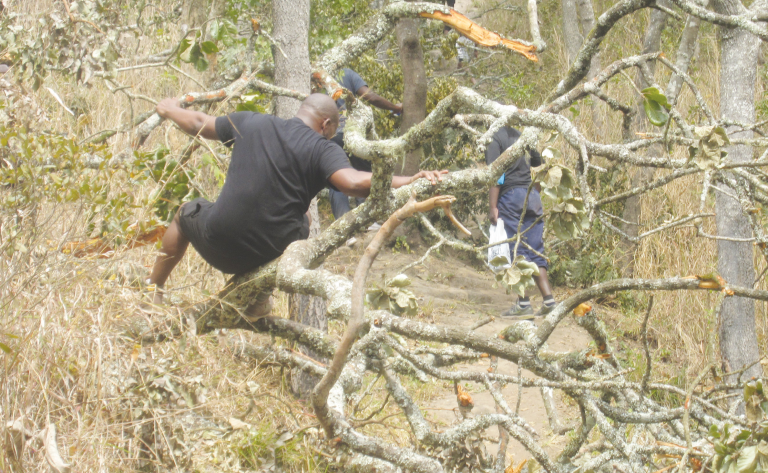The smell of freshly burnt grass is in the air. Patches of that burnt savannah grassland become clearer as you climb up nature trail one of the Michiru Mountain, the shortest route to the peak.
The felled trees are blocking the trails
Looking beyond the horizon, you can see the billows of smoke. More damage is being done to the savannah grassland.
As you go higher up the trail that takes you about 9 kilometres from the entry point to the peak 1 460 metres above the sea level, the damage is evident.
You find fallen trees on the nature trail. If you walk from the path, you find more fallen trees. Some of the fallen trees must be over 60 years old, so hard to replace for the natural trees.
Heaps of logs are all over the place. Whoever cut down the trees, must have had all the time to do so.
Essentially, the trail one was a crime scene when Nation on Sunday visited the trail last Saturday. The irreversible damage to the environment was evident, and the culprits must have been somewhere, calculating their moves to reclaim their loot.
While the other mountains surrounding have been bare, the Michiru Sanctuary , which is guarded by the Department of National Parks and Wildlife (DNPW) maintained its greenery, unlike the forest reserve that is manned by the Department of Forestry (DoF). The forestry side exposes high levels of deforestation and from on high, you can see the wafts of smoke emanating from charcoal urns.
Unlike Soche, Ndirande, Mpingwe and Mthawira that have lost their vegetation to farming activities and human habitation, Michiru has maintained its dignity. But with the desecration of the sanctuary, soon Michiru will be as bald.
At the peak, a guard who was escorting some other hikers, had his arms akimbo. An M16 rifle is hanging on his back. He shakes his head.
“No! This is too much! They used to cut down the trees that side, but now they are in the sanctuary! The sad part of it is that if we shoot any of the human rights activists will be on our necks,” said, clad in a green uniform.
Once he posted pictures of the damaged area on his Facebook Page, environmental educationist and adventurer Kondwani Chamwala had a host of negative comments from nature and environment enthusiasts.
Trees were cut with disregard
“One day, we will wake up to Malawi with no trees,” said one follower.
Another follower, said: “Previously we were worried about the forestry side. Now to go into the sanctuary, action is needed.”
Emmanuel Maliro, who like Chamwala, is just a sojourn from reaching the highest point in Africa, Uhuru Peak on Mount Kilimanjaro in Tanzaniam had a few words: “We went through hardest moments on the mountain. We realised the value of oxygen.”
While tagging President Lazarus Chakwera and other government officials, climate change and environmental activist Mathews Malata called for political will, as the country talks tough about conservation on the international scene.
“All our green spaces are vanishing. Malawi committed to restore 4.5 million hectares of degraded forests. At COP26 we pledged to halt deforestation.
“At the Unga [United Nations General Assembly], we are pledging more commitment in fighting climate change,” he said.
He called for an end to the ecocide—the human impact on the environment causing mass destruction to that environment.
He added: “We are in blackouts because of similar actions. We react to problems instead of dealing with the root cause. We are already late but any drastic solution would save the situation.”
Like a prophet of doom, in his post in March, Chamwala gave the mountain three months if the deforestation continued the way it was going.
In an interview, on Thursday, he was dismayed. He said it was worrisome that the plunderers have now made it into the nature sanctuary.
“It clearly shows someone somewhere is sleeping on the job. Whoever is dozing must be fired, not only transferred. Michiru is the only place in Blantyre to appreciate wildlife. We are engaging all stakeholders in the preservation of the mountain, it must be saved now! If nothing is done soon, we may have to demonstrate and present petitions to the necessary authorities,” added Chamwala.
DNPW director Bright Kumchedwa said he was aware of the damage into one of the most glorious spots in terms of natural vegetation in the commercial capital. He promised action.
He said: “We were alerted about the merciless cutting down of trees. We are going to act. I will not say how, but it will be soon. Previously, it was easy for them to infiltrate the forestry reserve, now it’s even worse that they are going into the sanctuary, which is a protected area to accord city residents a break from the hustle and bustle while at the same time learning about conservation.”
Several sources confided in Nation on Sunday that one of the reasons the sanctuary is more protected than the forest reserve is that rangers from the DNPW are armed with rifles, while those from DoF have no guns.
Kumchedwa said he was not aware if DoF guards are armed or not. “In the past, when they needed reinforcements we always came in to help. But I have not had any call for assistance from them,” said Kumchedwa.
While welcoming the idea of protesting against the plunder, Kumchedwa said dialogue was primary. “We will not just sit down idle. It is important that we sit down with the communities, activists and the activists to map the way forward.”
Urbanisation hits back
Charles Mkoka, secretary general of the Association of Environmental Journalists (AEJ) worked as the environmental education officer at the sanctuary between 1996 and 2000. He moaned that the degradation has reached this stage at the sanctuary, which covers about 46 square kilometres, some eight kilometres from Blantyre CBD.
Mkoka observed that the degradation is heightened largely by two factors, rooting from urbanisation. The first, he said, is a thriving brick-making industry along the Likhubula River by residents of Suya, Mdala and Mulunguzi villages.
“On the other hand, down the western peaks where you have villages like Chigwaja, you find the charcoal makers who have been on the onslaught against the Forestry Department.
“It is worrying to see that they are clearing the remaining valued Brachystegia species along the sanctuary nature trails. The species lined visitors most prized routes as they hike to the top. It is a sign of challenging authorities and surely it must be trimmed to size.”
According to him, the Michiru Mountain masterplan indicated multiple land use, with the two departments and the Chikunda Farm using the land in sustainable means.
“The problem that comes with the degradation is multi-faceted. The local community benefits from the water that comes from the mountain. Economically, some harvest mushrooms during the rainy season while others get tsekera grass from the mountain. Many more have beehives. We need not talk about the visitors who would love to sample life in the wild but can’t afford to go to national parks,” said Mkoka.
Covid-19 comes in
Wesm environment education officer Ausward Bonongwe said encroachment into the sanctuary, which was established as a conservation area in 1975, has heightened with the effects of the Covid-19 pandemic.
“Despite that degradation has been taking place massively in the forestry reserve, the sanctuary side was far better until 2019 when Covid-19 came. People became poorer, including those living close to the mountain reserve as many lost jobs among others,” he said.
At the time, he added, since schools were closed, parents also involved children in the poaching, causing pressures on staffers.
“Besides, human population around the mountain is increasing as whole areas around the mountain is becoming more urban. Demand for trees to be used to burn bricks is high around the mountain as people do not have their own trees community forests around the area,” he added.
Bonongwe said the society is currently looking for funding to support law enforcement and education, as well as community engagements to curb not only the cutting down of trees but also soil collection.
Death in the forest
Chief forestry officer Fatima Manda agreed with Bonongwe that there is growing animosity between her department and the largely farming community. At times, the villagers have resorted to farming in the protected area.
Manda recalls that last year, one of the forest rangers was killed in an operation.
“We told the villagers that cultivating in the reserve is criminal. They never listened. When they planted maize, we sent in people to slash it. A little later, we were doing our patrols and the rangers met a man with a bag of charcoal coming from the reserve.
“He told the rangers that the bag was not his, but as they were discussing out came a mob which overpowered the rangers. In the process, one of the guards was killed,” said Manda.
Bonongwe observed that the killing of the ranger contributed to other guards not to be vigilant.
According to Manda, the department is under-staffed with only 11 guards employed to cover the 4236.8 hectare reserve. “In an ideal situation, the reserve needs 70 guards. The other problem is that we only get K6 million annually when a minimum of K15 million would be adequate,” said Manda.
However, Senior Chief Kuntaja, in whose area the mountain blamed the Forestry Department for the negligence.
“Some forestry officials are involved in this syndicate. I wish we got to the roundtable to ease the degradation to this important resource that attracts tourists, adds beauty, shows history and is a habitat for wildlife,” he said.
The post 2022 marks the 20th anniversary of the Year of the Mountain, under which stakeholders pledged protection of mountains for sustainable development. As KONDWANI KAMIYALA finds out on the remnant mountain with foliage in Blantyre, Michiru Mountain, the fight against deforestation is just paying lip service. He writes: Desecrating Michiru Mountain appeared first on The Nation Online.
 Moni Malawi
Moni Malawi 

